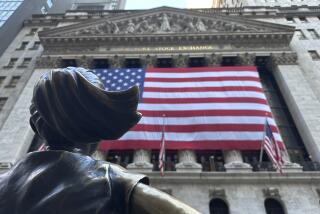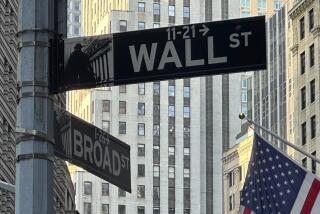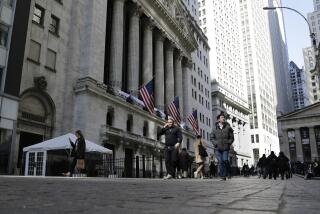Despite Negative News, Financial Stocks Have Fans
- Share via
Bank and savings and loan stocks have made liars and fools out of more analysts than Wall Street will ever care to admit.
So when the stocks turn hot--as they have in recent weeks--it’s cause for a lot of suspicion. Is this a real, sustainable surge for these battered issues, or is it just another brief trading rally?
The spark for the rally has been the slide in market interest rates since late April. That’s helping to relieve worries about a continuing rise in problem loans, because lower interest rates will make it easier for borrowers to hang on, while also lowering banks’ and S&Ls;’ cost of deposits.
In addition, lower rates could help jump-start the depressed real estate market, especially in California.
But the decline in interest rates may have run its course for now. Though the 30-year Treasury bond yield has fallen to 8.45% from 9.02% in late April, the bond rally sputtered on Tuesday, despite another plunge in oil prices.
Bank and S&L; stocks, however, continued to rise on Tuesday, following a strong rally on Monday. Which suggests that interest in these stocks may be as high as it has been in a while.
Many Wall Street analysts have been insisting since late in 1989 that the stocks are bargains and that worries about loan defaults--because of a soft economy--were overdone, especially in California. “I think it has become clear that the California real estate paranoia was carried to absurd extremes,” said Michael Abrahams, analyst at Bateman Eichler, Hill Richards in Los Angeles.
The current rally in financial stocks shows that more investors have come over to Abrahams’ point of view. But given that the stocks already are up 18% on average since the April 27 market low, how much steam is left?
Here’s one scenario: The stock market overall continues to move higher. More investors start searching frantically for stocks that look cheap. They see bank and S&L; stocks trading for five to eight times estimated 1990 earnings per share, while industrial stocks trade for an average 15 times earnings. What’s more, investors see that, despite the financial stocks’ gains since April, they’re still well below their 1989 peaks.
If that scenario plays out, it isn’t too difficult to take Abrahams’ view that BankAmerica stock, for example, will climb to the low- to mid-$40s over the next 18 months. The stock closed Tuesday at $33.125. The peak in 1989: $36.375.
Likewise, Dean Witter Reynolds analyst E. Gareth Plank’s still-bullish view of Great Western Financial and H. F. Ahmanson, two of California’s premier S&Ls;, is far easier to swallow if you believe that the stock market overall is going to stay healthy. And if you believe that interest rates aren’t going to rise sharply anytime soon.
If you’re searching for a financial stock that hasn’t yet rebounded much, analyst Donald Crowley at brokerage Keefe, Bruyette & Woods suggests San Francisco-based Union Bank. At $23.25, the stock--77% owned by Japan’s Bank of Tokyo--trades for just five times Crowley’s 1990 earnings estimate of $4.40 a share.
Crowley calls $15-billion-asset Union Bank “neglected and significantly undervalued,” despite its well-developed California franchise. The only concern is the bank’s relatively large portfolio of real estate construction loans. However, Crowley notes, 97% of the loans are in California, and the portfolio has had few problems to date.
What’s Avery Worth?Donaldson, Lufkin & Jenrette Securities analyst Katharine Plourde has gone out on a limb for Avery International, the Pasadena-based adhesives giant. Some of her peers say she’s out there without a safety net.
In a May 29 report, Plourde rated Avery stock a “buy,” citing the company’s May 25 announcement of a $500-million stock-swap merger with office products maker Dennison Manufacturing. Avery’s stock was at $28.50 before the announcement. It was at $26.25 the day of Plourde’s report. The price has continued to fall, to $24.625 on Tuesday.
Plourde believes that Avery represents “very good value.” Though the Dennison merger will dilute Avery’s earnings in 1990, Plourde still sees the merged company earning $2 a share this year and $2.20 in 1991. She believes that those results deserve a better stock price than $24.625.
Yet even if Plourde’s estimates are on target, that’s just 10% earnings growth between this year and 1991. Are those numbers going to set Wall Street on fire when so many growth stocks offer so much better potential?
Analyst Charles Rose at Oppenheimer & Co. doesn’t think so. Avery “overpaid for Dennison,” Rose contends. And he recalls that Avery’s history with acquisitions has been checkered at best. Permacel, one of Avery’s major purchases in the 1980s, turned out to be a disaster. The firm, which made specialty tape for the electronics industry, was sold in 1988.
No one disputes that Avery and Dennison fit well together. Avery has built a $1.7-billion (annual sales) business based on adhesives and adhesive products, such as labels and tapes. Dennison’s strength has been in stationery, labels, markers and various office products. Its sales topped $770 million last year.
The problem, says analyst Robert Bartels at William Blair & Co. in Chicago, is that both Avery and Dennison are facing trouble in key markets this year. Avery, for example, has seen its automotive-related sales soften and has been hit by the bankruptcies of major French diaper makers, which were Avery tape customers.
On May 11, Avery announced that second-quarter earnings will be down as much as 10% from a year ago.
Bartels believes that the stock market may still be expecting too much of Avery this year, even with already lowered expectations.
Though he is confident that Avery can eventually raise Dennison’s projected 10% annual earnings growth rate to 13% or 14%, the change will take time, Bartels said. In the meantime, the cost savings expected to be realized in merging the two companies won’t come quickly or easily, he said.
Avery has been a solid company over the past 10 years, but earnings growth hasn’t been consistent. Annual profits were mired in the $1.20-a-share range from 1984 to 1986. When first-quarter earnings this year came in flat at 46 cents a share, some analysts feared another tough cycle beginning.
Bartels, whose firm was Avery’s biggest shareholder earlier this year (1.38 million shares), admits that the money managers at his company “have been disappointed in Avery. . . . Some peoples’ patience has worn out.”
Long term, Avery still has a strong position in an interesting market. And it’s admirable that analyst Plourde is willing to take a definitive stand on the stock now. But to other analysts, it’s a stretch suggesting that investors will flock to Avery’s stock soon, when earnings growth looks mediocre at best into 1991.
Briefly: The stock offering of K-Swiss Inc., the Pacoima-based athletic shoe maker, was a big success: The firm went public Tuesday at $17.50 a share, and the stock quickly rocketed, to close at $22.50. Investors’ interest in the stock apparently wasn’t dampened by the plunge in shares of rival L.A. Gear last week. . . . Berkeley-based AgBiotech Stock Letter notes what a strange year we’re having in the stock market: Normally, January is a great month for stocks, and May is a lousy month. This year, January was a disaster, and May was stellar.
TOO LATE, OR JUST TURNING?
How some recommended bank and S&L; stocks have performed in the spring rally, and versus their 1989 highs:
Tues. close Pct. change from: 1990 Stock and change April 27 ’89 high P-E* Ahmanson $22, +1/4 +33.3% -12.0% 8 Great Western 20 1/4, unch. +25.6% -19.4% 8 Security Pacific 43 3/8, +1 1/8 +21.3% -20.9% 7 BankAmerica 33 1/8, + 1/2 +18.3% -8.9% 6 HomeFed Corp. 31, + 1/2 +15.9% -34.7% 5 Coast Savings 8 3/8, + 3/8 +6.3% -58.9% 4 Union Bank 23 1/4, +1/4 +4.5% -27.9% 5 S&P; financials 31.41, +0.26 +18.1% -10.9% 10
* Stock price-to-earnings ratio based on estimated 1990 earnings
More to Read
Inside the business of entertainment
The Wide Shot brings you news, analysis and insights on everything from streaming wars to production — and what it all means for the future.
You may occasionally receive promotional content from the Los Angeles Times.










